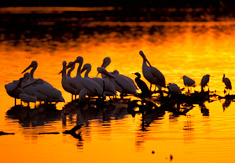 Estuary Restoration Act of 2000: Restore 1,000,000 acres of estuarine habitat by 2010 (RAE 2007).
Estuary Restoration Act of 2000: Restore 1,000,000 acres of estuarine habitat by 2010 (RAE 2007).
It is said that more than 140 million Americans live in coastal areas (EPA 2009) and more than 50% of the U.S. population live within 100 miles estuaries and coastal communities (EPA 2006).
Alaska, Florida, and Louisiana have the most acreage of estuaries in the United States; with Alaska containing the largest amount (Carter 1997)
The United States has 102 estuaries (ANEP 2007)
75% of commercial fisheries and 80-90% of recreational fisheries utilize estuaries as essential habitat (EPA, 2007).
Fish caught in estuaries add $4.3 billion a year to the U.S. economy (NOAA 2005c)
Recreational activities and tourism along coastal regions create $8-$12 billion per year in the U.S. (NOAA 2005c)
“Twenty-seven estuarine reserve sites make up the National Oceanic and Atmospheric Administration’s (NOAA) National Estuarine Research Reserve System (NERRS). These sites are located in 20 of the 35 U.S coastal states and protect over 1.3 million acres of coastal land and waters from Alaska to Puerto Rico.” (NOAA 2008)
“In one estuarine system in the Northeast that was studied some years ago it was found that commercial and recreational fishing generate about $240 million per year. In that same estuary, tourism and beach-going generate $1.5 billion per year, and shipping and marinas generate $1.86 billion per year. “( EPA 2009)
San Francisco Bay-Delta estuary:
- The 1,600 square miles of the San Francisco Bay-Delta estuary provides 40% of California’s drainage, supplies 4.5 million acres of agricultural lands with water, and quenches the thirst of 2/3 of the state’s population (SFEP 2002)
- Hosts 493,000 recreational and commercial boats per year
- Provides water for 4.5 million acres of farmland
- Water diversion provides water to 24 million Californians
- Supports sport & commercial fisheries and more than 200 hunting clubs
- Includes 290 coastal recreational spots
- Commercial transportation and military support: 300 marinas, 6 ports, 21 Naval facilities
- Vital to commercial and utility industry supporting more than 200 facilities
- According to the San Francisco Estuary Project, 50% of birds migrating the Pacific Flyway winter around the estuary, and the region, on average, has 600,000-800,000 waterfowl at any one time
(San Francisco Estuary Project 1999)

